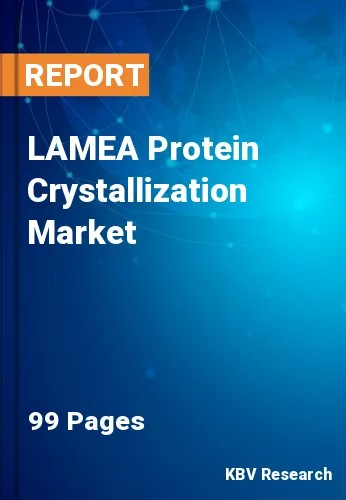The Latin America, Middle East and Africa Protein Crystallization Market would witness market growth of 14.4% CAGR during the forecast period (2022-2028).
Crystal growth happens in the drop if the proper crystallization solutions are used for the particular protein. This technique is used because it enables moderate, progressive variations in the protein and precipitant concentrations, which promote the maturation of sizable, well-ordered crystals. Protein crystals are created during protein crystallization and are subsequently employed in science and industry, primarily for X-ray crystallography research.
Vapor diffusion, micro-batch, microdialysis, and free-interface diffusion are techniques for the artificial production of protein crystals. Since it permits mild and progressive variations in protein and precipitant concentration, vapor diffusion is the most popular approach for crystallizing proteins because it promotes the formation of big, well-ordered crystals.
The UAE government has made building a top-notch healthcare infrastructure a priority; consequently, the industry has grown tremendously over the last few years. However, according to the World Health Organization, one in five UAE adults and adults aged 18 and over are obese. These people, backed by relatively high-income levels, will need higher quality healthcare as the prevalence of lifestyle illnesses rises. In order to make Dubai a regional hub of superior healthcare, the UAE government intends to increase the number of medical tourists visiting the country. In addition, the nation has a strong logistics and transportation network. It is strategically located to be the hub of a transportation network connecting the economies of China and India to those of Europe and the US, which helps the growth of the local healthcare sector. Over the forecast period, these factors are anticipated to promote the expansion of the local protein crystallization market.
The Brazil market dominated the LAMEA Protein Crystallization Market by Country in 2021, and would continue to be a dominant market till 2028; thereby, achieving a market value of $40.8 million by 2028. The Argentina market is experiencing a CAGR of 15% during (2022 - 2028). Additionally, The UAE market would display a CAGR of 14.1% during (2022 - 2028).
Based on End User, the market is segmented into Pharmaceutical & BioProduct Companies and Academic & Research Institutes. Based on Technology, the market is segmented into X-ray Crystallography, Cryo-electron Microscopy, NMR Spectroscopy and Others. Based on Product, the market is segmented into Instruments, Consumables and Software & Services. Based on Instruments Type, the market is segmented into Liquid Handling Instruments and Crystal Imaging Instruments. Based on Consumables Type, the market is segmented into Reagents & Kits/Screens, Micro Plates and Others. Based on countries, the market is segmented into Brazil, Argentina, UAE, Saudi Arabia, South Africa, Nigeria, and Rest of LAMEA.
Free Valuable Insights: The Worldwide Protein Crystallization Market is Projected to reach USD 1.8 Billion by 2028, at a CAGR of 8.4%
The market research report covers the analysis of key stake holders of the market. Key companies profiled in the report include Bruker Corporation, Corning Incorporated, Mettler-Toledo International, Inc., Greiner Bio-One International GmbH (Greiner AG), Rigaku Holdings Corporation, Formulatrix, Inc., Hampton Research Corp., Jena Bioscience GmbH, Creative Proteomics, and Molecular Dimentions Ltd (Anatrace Products LLC)
By End User
By Technology
By Product
By Country
Our team of dedicated experts can provide you with attractive expansion opportunities for your business.

